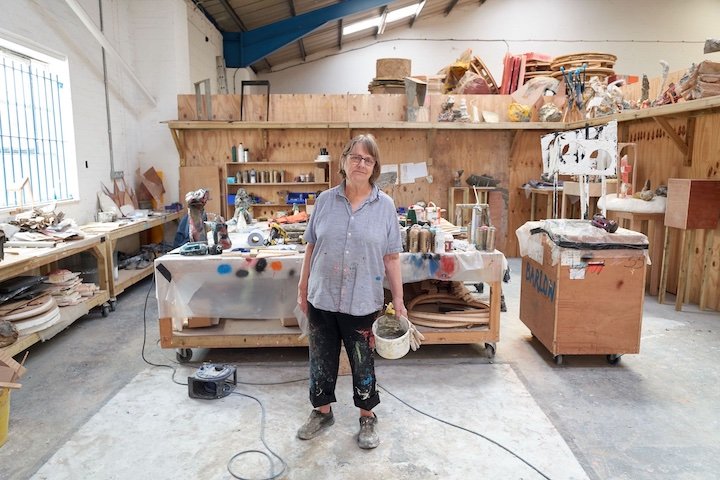Phyllida Barlow, British sculptor, dies aged 78
From Glimpse at Hauser and Wirth DTLA, Spring 2022, link here >>. photo: author
I’m quoting below from the obit in Hyperallergic, linked below. “Making from lightweight, disposable things pastiches the monument or the monumental,” she said in a 2010 interview. “The latter has this heroic, macho thing that I’m attracted to, but which conversely I couldn’t possibly do myself.”
In a 2018 review of the Phyllida Barlow: tilt exhibition at Hauser & Wirth for Hyperallergic, Thomas Michelli called Barlow’s forms “ugly, crude, and savage” — but “executed with such a wealth of wisdom and experience that, as we allow ourselves to sink into them, we can’t help but feel exalted.”
Phyllida Barlow in her studio (courtesy Hauser & Wirth)
Some of you may have had the chance to see Phyllida Barlow’s show at Hauser & Wirth DTLA in Spring 2022. What a masterwork of “non-monumental,” mythic forms. Massive, decaying stairwells to nowhere, ghostly shipwrecks, a fantastical gigantic, anthropomorphic assemblage that defies characterization. A dreamlike vision of a world abandoned and in ruins. I read numerous articles at the time of her passing; some thoughts relevant to this platform are highlighted below.
The Guardian quoted her reflecting on what inspired her work: “I have lots of references about damage and reparation and regeneration,” she said. “A kind of cycle of decay and regeneration. That fascinates me, because that is what my generation has witnessed, seeing London in ruins and then seeing it come up, and then fall down again.”
Reading in The Art Newspaper I linked through to a story from 2014, which identified her as “the artist working with the Tate collection to interrogate the essential nature of sculpture.” They go on to comment on her choice of material: “This output is especially prodigious given that Barlow’s modus operandi is to make unique sculptures-cum-structures for each location using vigorously manipulated commonplace materials—builders’ planks, sheets of plywood, plastic sheeting, plaster, scrim—on an epic scale.”
She continues, “So, I went back to the things that have always fascinated me about sculpture: the armature, the under-cladding, the trappings that get hidden. My work of the 1980s and 1990s was largely concerned with exposing hidden materials….The idea is to keep the moment of making alive, but to keep it in a raw state so things are hardly interfered with, because I’ve been layering things a lot in the past. Where there is paint, it is minimal and used to attract attention to a particular place, rather than being used as another material in its own right, like clay or plaster.”
“Your work seems to be grappling with issues of monumentality: you make huge sculptures but they are anti-monumental because they are made of cardboard, tape, plaster and stuff that isn’t built to last.
I have been asked, “Why is your work so big?” And I think the answer is to do with reach and stretch and going to spaces where I can’t get to and where we don’t usually go to in terms of looking or seeking out. The physical adventure of making the work reach there is not so much about the shape, but about the experience: I find it thrilling that you can make cardboard go up to ten metres. It fascinates me being able to make, in a day, something that high and tickling a part of the Duveen—making the relationship of the space to the piece of work slightly strange. It’s not to be utterly disrespectful, but it is saying, is this space only for the great and the good or can one put something slightly “bad” in there as well?
What I love about these readily available materials—cement, plaster, clay—is that the less you handle them, the more there is a sense of the moment trapped in them: as Louise Bourgeois said, the material does its own thing and you can’t argue with it.”

